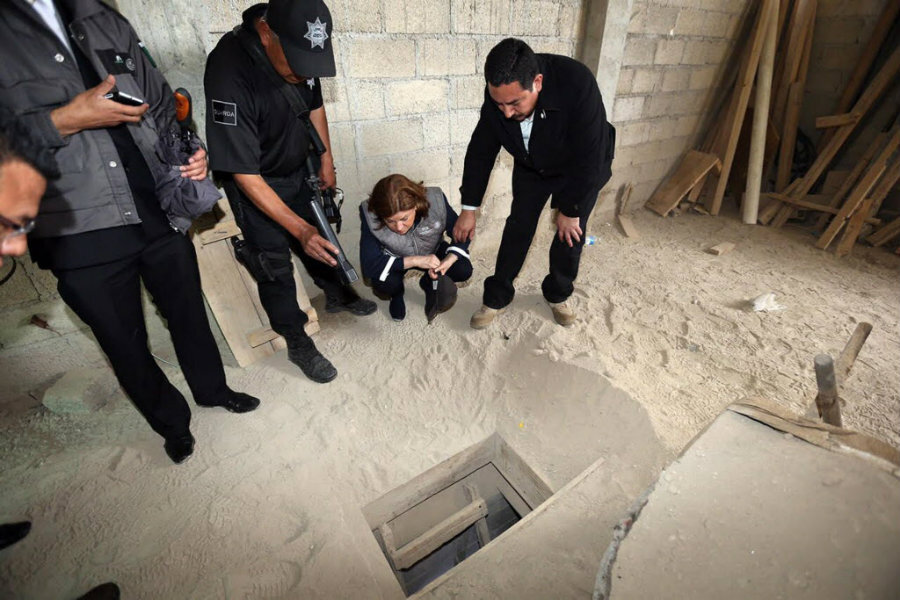Video of 'El Chapo' escape adds to myth surrounding Mexican drug lord
Loading...
A new video released Wednesday reveals how notorious drug kingpin Joaquin “El Chapo” Guzman escaped from a top Mexican prison over the weekend.
The footage, taken via surveillance camera, shows Mr. Guzman twice ducking behind a short shower wall in his cell at the maximum-security Altiplano prison. The first time he disappears, he resurfaces and goes back to his bed to change his shoes. Then he returns to the shower, bends down, and is not seen again.
The video fleshes out some of the details relating to Guzman’s break-out: The hole behind the shower wall led to a tunnel that ended at a half-built house about a mile from the prison, authorities said.
The footage also adds to the myth around Guzman, who as head of the country’s most powerful drug cartel has developed a larger-than-life, Robin Hood-like reputation, especially in his home state of Sinaloa.
“We’re glad,” a woman from Guzman’s hometown told CBS News. “In a way, the work and jobs generated by El Chapo benefit us.”
How is it that one of the main men behind Mexico’s bloody drug wars, which have claimed 100,000 lives over the last decade, is viewed by some as a hero?
Part of it, according to The Guardian’s Ed Vulliamy, is what El Chapo represents.
“He is, in his way, the last of the old-guard mafia dons, the last of that breed epitomised … by the figure of Marlon Brando as Don Corleone, the godfather,” Mr. Vulliamy wrote. “The last mafioso of the old school, who rules like a medieval baron, by consensus within his terrain and fearsome violence outside it.”
Born in the small city of Badiraguato in Sinaloa, Guzman grew up poor, selling oranges to get by. His uncle, however, pioneered Mexico’s drug-trafficking mafia in the 1960s and 70s, and by the late 1980s, Guzman was not only part of the family business – he was heading his own faction.
The lore surrounding him only grew when he was captured by authorities early in his leadership of the Sinaloa cartel. From prison, he built alliances with officials in public office and high politics, Vulliamy wrote. Then, in 2001, he broke out of El Puente Grande in a laundry cart.
In the years until his recapture in February 2014, Guzman became something of a legend. The Wall Street Journal reported in 2009:
In Culiacán, urban legends about El Chapo are daily bread. One says that a thief unwittingly robbed the capo’s niece’s car, and got his hands cut off by Mr. Guzman’s thugs as a lesson. In another, a former top state official reportedly fell for a local beauty and sent her an expensive gift. The gift was returned to his office along with a note from Mr. Guzman saying the girl was his. “Send her another gift and I’ll kill you,” the note said.
Separating fact from fiction is difficult.
His life has also inspired books, songs, and in one case, a 60-episode television series titled, “El Varón la Droga” (“The Drug Baron”). He has also been listed multiple times among Forbes magazine’s “Most Powerful.”
But those who have spent years covering and uncovering the narcotics trade out of Mexico have warned against glamorizing Guzman.
“He is a complete savage,” Tom Fuentes, a CNN law enforcement analyst, said. “What they do, and how they do business, is based on complete terror. ... They kill journalists, politicians, police officers, corrections officers. And then not just that person, but every member of their family.”
Guzman’s escape has led Mexican officials to launch a massive manhunt, fire the director and a slew of workers at the Altiplano prison, and offer a $3.8 million reward for details that lead to his recapture. The city of Chicago, a hub for the Sinaloa cartel’s US trafficking and distribution centers, has once again labeled Guzman, “Public Enemy No. 1.”
“The man is no Robin Hood – he’s a mass murderer,” Don Winslow, who has authored novels around a fictionalized version of Guzman, wrote in a CNN op-ed. “The last time that Chapo ‘escaped,’ his effort to put his empire back together touched off a decade-long war that caused untold suffering, left thousands of orphans, shattered communities and destroyed souls.”






